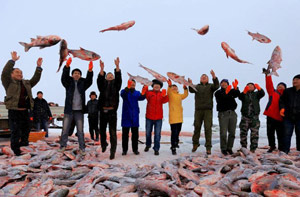Low rainfall and scorching heat in recent months have caused severe drought in a number of China's major crop producing regions, some of which are facing the worst drought in over half a century. Concerns about China's food security dominate discussions on the drought, but a more likely threat is the drought's negative impact on the incomes of farmers, especially poor smallholders.
According to recent news reports, severe drought has hit about a dozen provinces and regions in North China and the northeast plains. For example, rainfall levels in Henan province are reported to be about 60 percent of the past two decades' average, the lowest since 1951. This is serious because Henan accounts for 10 percent of China's cereal production, including a quarter of wheat and 9 percent of corn production. Local officials estimate that recent drought conditions are responsible for economic losses of up to 7.3 billion yuan ($1.2 billion), with 97 percent of these losses suffered by the agricultural sector.
Severe drought has also been reported in Northeast China's Liaoning province and North China's Inner Mongolia autonomous region, which produce about 7 and 9 percent of China's corn. According to the Flood Control and Drought Relief Headquarters, severe drought has affected about 5 million hectares of farmland and left 1.6 million people without adequate water supply.
The Chinese government has a number of policy options to mitigate the possible threat to food security and lessen the damage to farmers' livelihoods in the short and long term. China has large corn stocks that can be released to the market. According to Food and Agriculture Organization estimates, China's corn stocks this year are 27 percent higher than the 2011-2013 average. The government bought these grains above market prices as part of its growing portfolio of interventions to protect and provide support to farmers.
Increasingly integrated international markets and trade channels are also an effective and efficient tool to offset drought-related agricultural production and supply shocks. The United States recently announced that it expects record corn and soybean harvests in the coming months. As a result, international prices of US corn fell to their lowest levels since August 2010, with current prices nearly half of their peak 2011 levels; international soybean prices too have fallen in recent weeks. China can thus benefit from the US bumper harvest to fill the gap between domestic agricultural supply and demand through imports.

 Music at her fingers
Music at her fingers
 Across America Over the Week (Jan 16 - Jan 22)
Across America Over the Week (Jan 16 - Jan 22)
 Spend Chinese New Year in style
Spend Chinese New Year in style
 Ili river valley becomes a popular destination for swans
Ili river valley becomes a popular destination for swans
 Philip Ma: from scientist to businessman
Philip Ma: from scientist to businessman
 Birmingham's Spotlight on China dinner
Birmingham's Spotlight on China dinner
 How to distinguish doucai, wucai, Famille-rose and enamel porcelain
How to distinguish doucai, wucai, Famille-rose and enamel porcelain
 Xinjiang lake in bumper fishing season
Xinjiang lake in bumper fishing season















